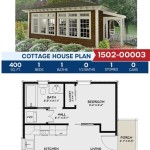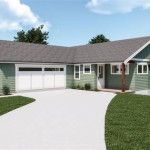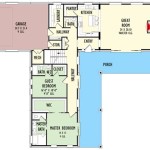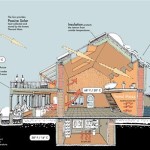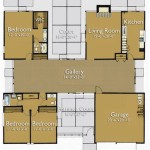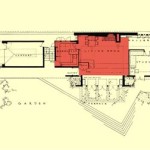Modern Farmhouse Style House Plans: A Comprehensive Overview
Modern farmhouse style has become a ubiquitous architectural aesthetic, blending the rustic charm of traditional farmhouses with contemporary design elements and conveniences. This style's popularity stems from its ability to create a warm, inviting, and functional living space that appeals to a broad range of homeowners. Modern farmhouse house plans are available in a diverse array of sizes, layouts, and architectural interpretations, providing ample opportunity for personalization and adaptation to specific site conditions and lifestyle needs.
The core of modern farmhouse design revolves around simplicity, comfort, and a connection to nature. The emphasis is on creating a relaxed and approachable atmosphere, often characterized by light-filled interiors, natural materials, and a seamless integration of indoor and outdoor spaces. While retaining the essential architectural characteristics of classic farmhouses, modern iterations incorporate features such as open floor plans, updated kitchen and bathroom designs, and energy-efficient technologies. Understanding the key elements and considerations involved in modern farmhouse house plans is crucial for achieving a cohesive and aesthetically pleasing outcome.
The construction process for a modern farmhouse typically adheres to standard building practices. However, selecting the right materials and ensuring proper execution of design details is crucial to achieving the desired aesthetic. While the style often evokes a sense of nostalgia and historical precedent, modern building codes and regulations must be strictly adhered to. This often necessitates a collaboration between architects, builders, and homeowners to achieve a balance between the desired visual effect and necessary structural and safety requirements.
Key Elements of Modern Farmhouse Design
Several design elements are fundamental to achieving the modern farmhouse aesthetic. These elements are often integrated in varying degrees depending on personal preference, site conditions, and budget constraints. However, a consistent application of these principles is essential for maintaining a cohesive and recognizable design identity.
Exterior Features: The exterior of a modern farmhouse typically features a gabled roof, often with multiple gables of varying sizes. A prominent front porch is a nearly ubiquitous element, providing a welcoming transition between the exterior and interior. White or light-colored siding is common, often paired with dark-colored window frames and roofing. Board and batten siding, shiplap, and brick accents are frequently used to add texture and visual interest.
Windows are typically large and strategically placed to maximize natural light. Multi-pane windows are often favored, evoking a traditional farmhouse aesthetic. The use of black or dark bronze window frames provides a modern contrast against the light-colored siding. Exterior lighting fixtures are often simple and functional, with a focus on practicality and illumination. Gooseneck barn lights and pendant lights with exposed bulbs are common choices.
Landscaping plays a crucial role in complementing the architectural style. Naturalistic landscaping, with an emphasis on native plants and informal plantings, is often preferred. Gravel driveways, stone walkways, and simple fencing contribute to the overall rustic charm. A vegetable garden or herb garden can further enhance the connection to nature and reinforce the farmhouse aesthetic.
Interior Features: Open floor plans are a hallmark of modern farmhouse interiors, promoting a sense of spaciousness and connectivity. The kitchen is often the heart of the home, with a large island serving as a focal point for cooking, dining, and gathering. Shaker-style cabinetry is a common choice, often painted white or a light neutral color. Quartz or granite countertops provide a durable and aesthetically pleasing surface.
Hardwood flooring is a common feature, adding warmth and character to the interior spaces. Wide-plank floors are often preferred, evoking a sense of rustic authenticity. Neutral color palettes are prevalent, with white, gray, and beige serving as the foundation. Accent colors are often introduced through furniture, accessories, and artwork. Natural materials, such as wood, stone, and metal, are used extensively throughout the interior to create a sense of warmth and texture.
Fireplaces are often incorporated into the living room or family room, providing a focal point and source of warmth. Stone or brick fireplaces are common choices, often with a simple and understated design. Exposed beams are another popular feature, adding architectural interest and reinforcing the rustic aesthetic. Shiplap walls are frequently used to add texture and visual interest to interior spaces. Modern farmhouse interiors often incorporate vintage or antique furniture pieces, mixed with contemporary elements to create a balanced and eclectic aesthetic.
Considerations When Choosing a Modern Farmhouse House Plan
Selecting the appropriate modern farmhouse house plan requires careful consideration of multiple factors, including site conditions, lifestyle needs, budget constraints, and aesthetic preferences. A thorough assessment of these factors is essential for ensuring a successful and satisfying outcome.
Site Conditions: The topography, orientation, and soil conditions of the building site will significantly influence the design and layout of the house. The house plan should be adapted to the specific site conditions to maximize natural light, views, and energy efficiency. Consider the prevailing winds, solar orientation, and drainage patterns when positioning the house on the lot. Ensure that the house plan complies with all applicable zoning regulations and building codes. The size and shape of the lot will also influence the size and footprint of the house.
Lifestyle Needs: The house plan should be tailored to the specific lifestyle needs of the occupants. Consider the number of bedrooms and bathrooms required, as well as the need for specific spaces, such as a home office, playroom, or media room. The layout of the house should promote functionality and flow, with consideration given to traffic patterns and accessibility. The kitchen should be designed to meet the specific needs of the cook, with ample counter space, storage, and appliances. Outdoor living spaces, such as porches, patios, and decks, should be integrated into the design to extend the living space and promote connection to nature.
Budget Constraints: The budget available for construction will significantly influence the scope and complexity of the house plan. It is essential to establish a realistic budget early in the planning process and to prioritize features and finishes accordingly. Consider the cost of materials, labor, and permits when developing the budget. Value engineering techniques can be employed to reduce costs without sacrificing quality or functionality. The size and complexity of the house will directly impact the overall cost of construction. Simple and efficient designs are often more cost-effective than complex and elaborate designs.
The Role of Technology and Sustainability in Modern Farmhouse Design
While modern farmhouse design draws inspiration from traditional styles, it is crucial to integrate modern technologies and sustainable building practices to create a comfortable, energy-efficient, and environmentally responsible home. Modern farmhouse house plans should incorporate features such as energy-efficient windows and doors, high-performance insulation, and efficient heating and cooling systems.
Smart home technology can be seamlessly integrated into the design to enhance convenience, security, and energy efficiency. Features such as smart thermostats, lighting controls, and security systems can be controlled remotely via smartphone or tablet. Solar panels can be installed on the roof to generate renewable energy and reduce reliance on fossil fuels. Rainwater harvesting systems can be used to collect and store rainwater for irrigation and other non-potable uses. Sustainable building materials, such as reclaimed wood, bamboo flooring, and recycled content insulation, can be used to reduce the environmental impact of the construction process.
Proper insulation is crucial for maintaining a comfortable indoor temperature and reducing energy consumption. High-performance windows and doors can minimize heat loss in the winter and heat gain in the summer. Efficient heating and cooling systems, such as heat pumps and geothermal systems, can significantly reduce energy costs. Tankless water heaters provide on-demand hot water, eliminating the need for a storage tank and reducing energy waste. Low-flow plumbing fixtures can conserve water and reduce water bills. Proper ventilation is essential for maintaining indoor air quality and preventing moisture buildup.

Modern Farmhouse Plans Designs Barn Style Home

Farmhouse Style House Plan 4 Beds 3 5 Baths 2763 Sq Ft 430 205 Plans

10 Amazing Modern Farmhouse Floor Plans Farmhousefloorplan House

Farmhouse Style House Plans For The Modern Family

4 Bedroom 1 Story Modern Farmhouse Style Plan With Outdoor Living Area And Bonus Room Westchester Craftsman House Plans

2 Story Modern Farmhouse Style House Plan Waco Flats Plans

Beautiful Modern Farmhouse Style House Plan 4383 Remington Ridge

Plan 80864 Style Modern Farmhouse With 1698 Sq Ft 3
Modern Farmhouse Plan Free 10 Best Floor Plans Farm Style House Blueprints Civiconcepts

Farmhouse Plans Modern Designs Cool House


